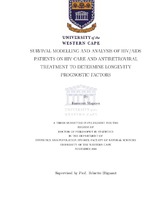| dc.contributor.advisor | Blignaut, Renette | |
| dc.contributor.author | Maposa, Innocent | |
| dc.date.accessioned | 2017-06-29T14:54:32Z | |
| dc.date.available | 2017-06-29T14:54:32Z | |
| dc.date.issued | 2016 | |
| dc.identifier.uri | http://hdl.handle.net/11394/5444 | |
| dc.description | Philosophiae Doctor - PhD | en_US |
| dc.description.abstract | The HIV/AIDS pandemic has been a torment to the African developmental agenda,
especially the Southern African Development Countries (SADC), for the past two
decades. The disease and condition tends to affect the productive age groups. Children have also not been spared from the severe effects associated with the disease. The advent of antiretroviral treatment (ART) has brought a great relief to governments and patients in these regions. More people living with HIV/AIDS have experienced a boost in their survival prospects and hence their contribution to national developmental projects. Survival analysis methods are usually used in biostatistics, epidemiological modelling and clinical research to model time to event data. The most interesting aspect of this analysis comes when survival models are used to determine risk factors for the survival of patients undergoing some treatment or living with a certain disease condition. The purpose of this thesis was to determine prognostic risk factors for patients' survival whilst on ART. The study sought to highlight the risk factors that impact the survival time negatively at different survival time points. The study utilized a sample of paediatric and adult datasets from Namibia and Zimbabwe respectively. The paediatric dataset from Katutura hospital (Namibia) comprised of the adolescents and children on ART, whilst the adult dataset from Bulawayo hospital (Zimbabwe) comprised of those patients on ART in the 15 years and above age categories. All datasets used in this thesis were based on retrospective cohorts followed for some period of time. Different methods to reduce errors in parameter estimation were employed to the datasets. The proportional hazards, Bayesian proportional hazards and the censored quantile regression models were utilized in this study. The results from the proportional hazards model show that most of the variables considered were not signifcant overall. The Bayesian proportional hazards model shows us that all the considered factors had different risk profiles at the different quartiles of the survival times. This highlights that by using the proportional hazards models, we only get a fixed constant effect of the risk factors, yet in reality, the effect of risk factors differs at different survival time points. This picture was strongly highlighted by the censored quantile regression model which indicated that some variables were significant in the early periods of initiation whilst they did not significantly affect survival time at any other points in the survival time distribution. The censored quantile regression models clearly demonstrate that there are significant insights gained on the dynamics of how different prognostic risk factors affect patient
survival time across the survival time distribution compared to when we use proportional hazards and Bayesian propotional hazards models. However, the advantages of using the proportional hazards framework, due to the estimation of hazard rates as well as it's application in the competing risk framework are still unassailable. The hazard rate estimation under the censored quantile regression framework is an area that is still under development and the computational aspects are yet to be incorporated into the mainstream statistical softwares. This study concludes that, with the current literature and computational support, using both model frameworks to ascertain the dynamic effects of different prognostic risk factors for survival in people living with HIV/AIDS and on ART would give the
researchers more insights. These insights will then help public health policy makers
to draft relevant targeted policies aimed at improving these patients' survival time
on treatment. | en_US |
| dc.language.iso | en | en_US |
| dc.publisher | University of the Western Cape | en_US |
| dc.subject | Survival modelling | en_US |
| dc.subject | Prognostic factors | en_US |
| dc.subject | Bayesian proportional hazards model | en_US |
| dc.subject | Survival analysis | en_US |
| dc.subject | Antiretroviral therapy (ART) | en_US |
| dc.subject | HIV/AIDS | en_US |
| dc.subject | Patients | en_US |
| dc.subject | Zimbabwe | en_US |
| dc.subject | Namibia | en_US |
| dc.title | Survival modelling and analysis of HIV/AIDS patients on HIV care and antiretroviral treatment to determine longevity prognostic factors | en_US |
| dc.rights.holder | University of the Western Cape | en_US |

